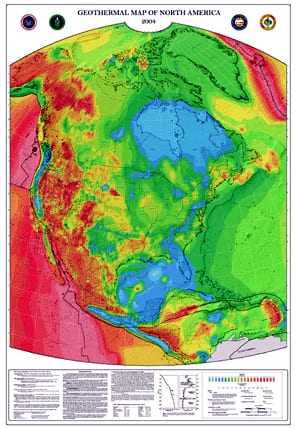Texas, which has been the nation’s largest fossil-fuel producer, also has an abundant supply of another natural resource for a different kind of energy boom: clean, renewable, geothermal energy.
Like the oil and gas beneath Texas, there’s a huge quantity of naturally occurring “hot rocks” underground that could be tapped for geothermal energy to produce electricity, according to new research by SMU scientists. South and East Texas have an abundant supply, say the researchers.
 “There is more than enough heat below our feet to take all the state’s industrial consumption off the existing transmission grid,” says Maria Richards, program coordinator for the SMU Geothermal Laboratory.
“There is more than enough heat below our feet to take all the state’s industrial consumption off the existing transmission grid,” says Maria Richards, program coordinator for the SMU Geothermal Laboratory.
Lab researchers recently completed an assessment of geothermal resources in South and East Texas for the Texas State Energy Conservation Office, or SECO. They found enough heat to supply Texas with clean, renewable, affordable electricity for hundreds of years, Richards says. Some of the state’s largest urban areas sit atop the vast regional geothermal zone, which extends east from Interstate 35 and includes Dallas-Fort Worth, Houston, Austin, Corpus Christi and Kilgore.
Maria Richards with a driller on an oil rig.
The SMU analysis will be part of The Energy Report, a SECO report on clean and renewable energy resources in Texas. SECO funded the SMU Geothermal Laboratory research with a $200,000 grant. SMU will submit the assessment to SECO later in June.
Currently Texas gets the bulk of its electricity from natural gas-, coal- and nuclear-powered generating plants. But commercial interest in geothermal energy is growing both in the state and nationwide, says David Blackwell, one of the country’s foremost authorities on geothermal energy and a professor at SMU. Over the past 12 months, SMU’s Geothermal Laboratory has received a record number of requests from private entities asking for help in developing commercial projects, says Blackwell, who has advised the industry for the past 40 years.
Pioneers in assessing the nation’s geothermal resources, Blackwell and Richards revealed the potential for widespread geothermal development with their Geothermal Map of North America, published in 2004 by the American Association of Petroleum Geologists.
The two also helped author a 2007 study led by Massachusetts Institute of Technology that found geothermal energy could supply a substantial amount of the energy the United States will need in the future, likely at competitive prices and with minimal environmental impact. The MIT study’s authors said geothermal energy is especially attractive because it is widely available, doesn’t have to be stored to supply minimum demand, and has a small footprint with low or no emissions. It is also considered virtually inexhaustible, according to the Geothermal Energy Association.
The MIT study estimated the U.S. geothermal resource base at more than 13 million exajoules, which is a measurement of stored thermal energy. The extractable portion of that is estimated at more than 200,000 exajoules, or about 2,000 times the annual U.S. consumption in 2005 of primary energy, according to the report.
Currently the U.S. has more geothermal generating capacity online than any other country, about 30% of the world’s total, according to the Geothermal Energy Association.
 Texas is uniquely positioned for geothermal development, according to Blackwell and Richards. That’s due in large part to the state’s thousands of existing oil and gas wells that could be developed in various ways to tap geothermal heat.
Texas is uniquely positioned for geothermal development, according to Blackwell and Richards. That’s due in large part to the state’s thousands of existing oil and gas wells that could be developed in various ways to tap geothermal heat.
Pictured right: Michael Paul, SMU director of energy management and engineering, collects temperatures at a field near Corpus Christi
The SMU Geothermal Lab’s research has proven the potential for drawing electricity from low-temperature geothermal sources through “binary” technology. A binary power plant circulates hot groundwater through an existing oil or gas well to heat a secondary fluid. The resulting vapor then drives turbines to generate electricity.
There are thousands of oil and gas wells in Texas that could be economical for geothermal development, Richards says. That’s especially true since the technology can operate concurrently in oil and gas wells, which would significantly reduce the cost of geothermal exploration. Geothermally produced electricity could then offset the power normally required to operate oil-field production units. Additionally, excess electricity could be sold back to the statewide electric transmission grid. Depleted oil and gas wells that are slated for abandonment could again generate revenue when tapped for geothermal production.
SMU’s regional assessment for SECO covered 91 counties. It calculated the geothermal heat under South and East Texas at 921,085 exajoules, giving the state enormous geothermal potential. Anywhere from 2 percent to 10 percent of that is recoverable, depending on the efficiency of the conversion technology and the location of the resource.
“As humans we have no real concept as to how much heat is below our feet,” Richards says. “We feel the sun in our face, and the wind in our hair, but we don’t feel the Earth’s heat through our feet.”
SMU’s researchers analyzed historical temperature data for wells drilled since the early 1990s. Drilling logs for each hole include temperature recordings taken at various depths. The SMU analysis looked at wells ranging from 2,000 feet to 20,000 feet deep. The researchers were surprised that the temperature in some wells ran as hot as 450 degrees Fahrenheit, Richards says.
Wells drilled from 9,000 feet to 14,000 feet deep, with temperatures downhole of 250 degrees or greater, will likely be economical for geothermal energy. They would be sufficiently hot and reasonably close to the surface. In deeper wells, unless they flow naturally, the binary technology would require too much electricity.
The team of SMU Geothermal Laboratory researchers included six graduate and undergraduate students.
“This turned out to be a wonderful project for the students,” Richards says. “With President Barack Obama’s push for more emphasis on science and renewable energy, these are students on the leading edge of that whole process. And they are focused on a project that was funded by the state of Texas.” — Margaret Allen
Related links:
SMU Geothermal Energy Utilization Conference
SECO: Texas Geothermal Energy
Google invests in SMU geothermal research
Google video on advanced geothermal technology
CBN News: Geothermal energy right under our feet
SMU Research News: Earth’s inner heat can generate electric power
SMU geothermal home
SMU Geothermal Laboratory
David Blackwell
Renewable Electricity Production Tax Credit
Roy M. Huffington Department of Earth Sciences








 The U.S. Department of Energy’s Rocky Mountain Oilfield Testing Center, RMOTC, in partnership with the U.S. Department of Energy’s National Renewable Energy Laboratory, NREL, and Southern Methodist University
The U.S. Department of Energy’s Rocky Mountain Oilfield Testing Center, RMOTC, in partnership with the U.S. Department of Energy’s National Renewable Energy Laboratory, NREL, and Southern Methodist University 
 “There is more than enough heat below our feet to take all the state’s industrial consumption off the existing transmission grid,” says Maria Richards, program coordinator for the
“There is more than enough heat below our feet to take all the state’s industrial consumption off the existing transmission grid,” says Maria Richards, program coordinator for the